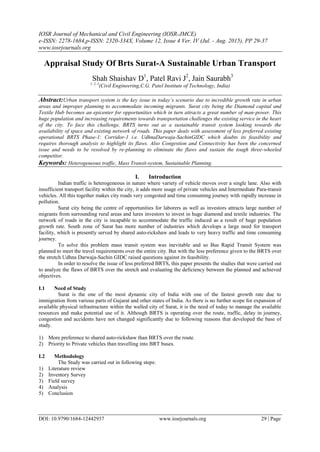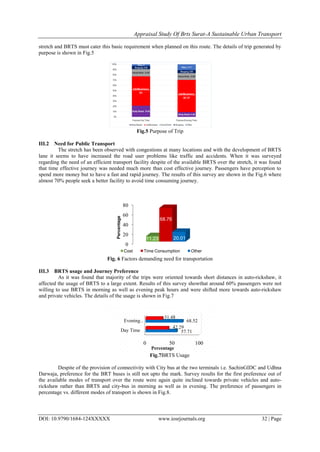The document summarizes an appraisal study of the Bus Rapid Transit System (BRTS) in Surat, India. The BRTS Phase 1 corridor from Udhna Darwaja to Sachin GIDC was selected for analysis. Surveys found that while BRTS provided faster journey times than auto-rickshaws, it lacked accessibility for passengers at intermediate stops. As a result, 60% of passengers preferred auto-rickshaws to BRTS during peak hours. The study concluded that improving accessibility at stops is needed to make BRTS more sustainable and preferred over the entire route.







![Appraisal Study Of Brts Surat-A Sustainable Urban Transport
DOI: 10.9790/1684-124XXXXX www.iosrjournals.org 36 | Page
2) BRTS stops fails to cover certain major access locations over the route where large passenger traffic is
observed.
3) Private vehicle holders seek for parking facility and quick connectivity at the stops to ease their modal shift.
4) Perception of people to spend money rather than walking even 200 m.
V. Suggestions
1) Operation of all phases of BRTS in the city could result in more number of passengers having their origins
from farther locations and destinations over the selected route and certainly could increase the Bus
occupancy.
2) Re-locating BRT stops at certain major access points where large passenger traffic is observed or by
shifting of some stops towards the junction by marginal distance as by decreasing even 100 m walking
distance might attract more passengers than before.
3) Provision for the passenger in the bus such that passenger can indicate to the driver for his alighting station
as it will avoid unnecessary stoppage time and consumption of energy at intermediate stops where no
passengers are likely to board or alight.
4) Strict enforcement of law encouraging metered rickshaw once the project starts operating in the entire city.
5) Provision of Digital Indicators outside the BRT stop which could guide them regarding the arrival and
departure of bus, might attract more passengers than before as per the perception found during the survey.
Acknowledgement
We would like to take this opportunity to bestow our acknowledgements to all the persons who have
directly or indirectly been involved with us in making our project feasible and to run it up into a successful piece
of work.
It is the product of many hands, and countless hours from many people. Our thanks go to all those who
helped, whether through their comments, feedback, edits or suggestions. We express a deep sense of gratitude to
the Head of the Civil Department, Prof. Kamlesh Gandhi for providing a suitable environment, where we
can implement our work. Moreover, we would like to thank our guide DR. N .C. SHAH, Asst. Prof. Rinkal
Patel, Asst. Prof. Mehul Patel and Asst. Prof. ApurvaSutharwho has helped us throughout our project
development.
References
[1] AbsarAlam and Faisal Ahmed (2013),” Urban Transport Systems and Congestion: A case study of Indian
cities”.Available:trid.trb.org/view.aspx?id=1298722
[2] AdvaniMukti, Srirama B., Pathan S. K.(2008) - Improvement in Transit service using GIS- Case study of
BhavnagarAvailable:http://www.academia.edu/7604699/Improvement_in_Transit_Service_using_GIS__Case_study_of_Bhavnagar
_State_TransportDepot
[3] ChaurasiaDevarshi (2014), “Bus Rapid Transit System (BRTS): A Sustainable Way of City Transport (Case Study of Bhopal
BRTS)”.Available: http://www.ijeat.org/attachments/File/v3i4/D2807043414.pdf
[4] JaiswalAnuj, Sharma Ashutosh, Yadu Krishnan (2012),”Potential Of Bus Rapid Transit System: A Case Study Of Ahmedabad”
Available:http://www.technicaljournalsonline.com/ijaers/VOL%20I/IJAERS%20VOL%20I%20ISSUE%20III%20APRIL%20JUN
E%202012/169.pdf
[5] KandyaAnurag, KolliNarendrareddy, Manju Mohan, Pathan S K., PandeySucheta (2011), “Dynamics of Urbanization and its
Impact on Land-Use/Land-Cover: A Case Study of Megacity Delhi”Available:
http://www.scirp.org/journal/PaperInformation.aspx?PaperID=8286
[6] Yim Y.B. (2006), “Smart Feeder Bus Service: Consumer Research &Design”Available:
http://scholarcommons.usf.edu/jpt/vol9/iss1/5/
[7] TaralShukla,Asso.Prof.ManjiriAkalkotkar,” Organizing the Role of the Intermediate Public Transport Sector: Focus on auto
rickshaw services.” CEPT University, Ahmedabad, Gujarat, 2012.
[8] “Detailed Project Report of Surat BRTS”, CEPT University, Ahemedabad, Gujarat, 2008.
[9] “Comprehensive Mobility Plan of Surat City”, CEPT University, Ahemedabad, Gujarat, 2008.
Authors
Shah Shaishav D1
, IVYear,
B.TECH Civil Engineering,
ChhotubhaiGopalbhai Patel Institute of Technology,
Uka Tarsadia University,
Surat-Gujarat,
India.
Email: shaishavdshah@gmail.com
Contact: +919558319452](https://image.slidesharecdn.com/e012442937-160711061907/85/E012442937-8-320.jpg)
